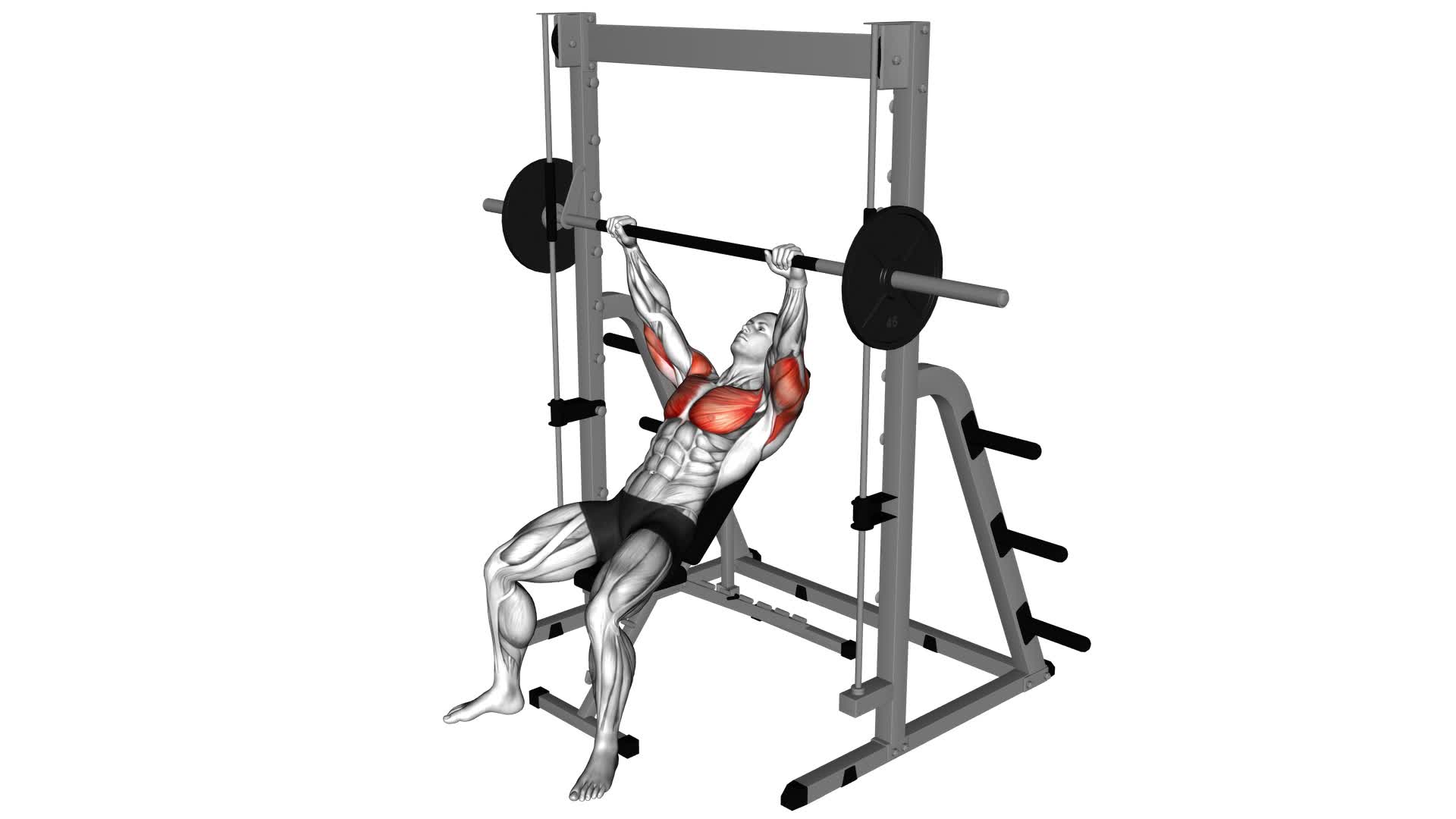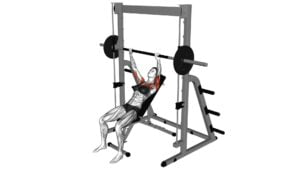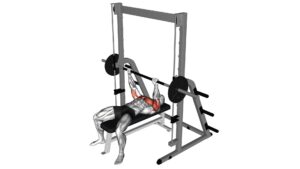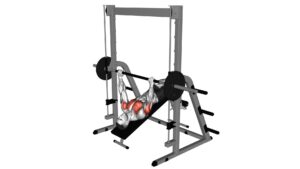Smith Incline Bench Press – Video Exercise Guide & Tips

Are you looking for an effective chest workout? Look no further than the Smith Incline Bench Press!
Watch This Exercise Video
This video exercise guide will show you the proper form and technique to maximize your results.
You'll also find helpful tips to avoid common mistakes and challenge your chest muscles even further with variations and modifications.
Get ready to sculpt and strengthen your chest with the Smith Incline Bench Press!
Key Takeaways
- Targets specific muscles such as the upper chest, shoulders, and triceps
- Provides greater stability and control compared to traditional bench press variations
- Helps overcome training plateaus and stimulate muscle growth
- Reduces the risk of injury
Benefits of the Smith Incline Bench Press
You can experience several benefits by incorporating the Smith Incline Bench Press into your workout routine.
One of the main advantages of this exercise is its ability to target specific muscles. The incline angle of the bench puts more emphasis on your upper chest, shoulders, and triceps, helping you develop a well-rounded upper body. By incorporating the Smith Incline Bench Press into your routine, you can effectively work these muscles and see notable improvements in their strength and size.
Additionally, this exercise allows for greater stability and control compared to traditional bench press variations. The guided barbell movement in the Smith machine reduces the risk of injury and helps you maintain proper form throughout the exercise. This can be particularly beneficial for beginners or individuals with limited experience in weightlifting.
Including the Smith Incline Bench Press in your workout routine can also help you break through plateaus and stimulate muscle growth. By introducing a new and challenging exercise, you challenge your muscles in different ways, promoting muscle adaptation and growth. This can help you overcome training plateaus and continue progressing towards your fitness goals.
Proper Form and Technique for the Exercise
To perform the Smith Incline Bench Press with proper form and technique, it's important to focus on maintaining a stable and controlled movement throughout the exercise.
Start by adjusting the bench to a 30-45 degree incline. Lie on the bench with your feet flat on the ground and your back pressed firmly against the pad. Grasp the barbell with an overhand grip slightly wider than shoulder-width apart.
Lower the barbell slowly and under control towards your upper chest, keeping your elbows slightly tucked in. Pause for a moment at the bottom of the movement, then push the barbell back up to the starting position, fully extending your arms.
It is crucial to avoid some common mistakes when performing the Smith Incline Bench Press. One common mistake is arching your back excessively, which can lead to lower back strain. Another mistake is using too much weight, compromising your form and risking injury. Remember to use a weight that allows you to maintain proper technique throughout the exercise.
There are variations and modifications of the Smith Incline Bench Press that you can incorporate into your routine. You can try using dumbbells instead of a barbell to work on stabilizing muscles. You can also try alternating between a narrow grip and a wide grip to target different areas of your chest. Additionally, you can perform the exercise on an adjustable incline bench to target different angles of your upper chest.
Tips for Maximizing Your Results With the Smith Incline Bench Press
To maximize your results with the Smith Incline Bench Press, it's important to focus on proper form and gradually increase the intensity of your workouts. By following these tips, you can maximize gains and make your workouts more effective.
Firstly, ensure that you maintain proper form throughout the exercise. Keep your back flat against the bench, your feet firmly planted on the ground, and grip the barbell with your hands slightly wider than shoulder-width apart. This will help engage the muscles in your chest, shoulders, and triceps more effectively.
Secondly, gradually increase the weight and intensity of your workouts. Start with a weight that challenges you but allows you to maintain proper form. As you become stronger, progressively increase the weight to continue challenging your muscles and promoting growth.
Additionally, vary your grip width and angle of incline to target different areas of your chest and shoulders. By using a wide grip, you can emphasize your chest muscles, while a narrow grip places more focus on your triceps.
Lastly, remember to incorporate proper breathing techniques. Exhale as you push the barbell up and inhale as you lower it down. This will provide stability and help you generate more power during the exercise.
Common Mistakes to Avoid While Performing the Exercise
To ensure proper form and maximize your results with the Smith Incline Bench Press, it's crucial to avoid common mistakes while performing the exercise. Here are some common mistakes to watch out for and tips on how to perform the exercise correctly:
- Using too much weight: It's important to start with a weight that allows you to maintain proper form throughout the exercise. Using too much weight can lead to improper technique and potential injuries.
- Arching your back excessively: Avoid excessive arching of the back as it puts unnecessary strain on the lower back. Keep your back flat against the bench throughout the exercise.
- Flaring your elbows out: To target your chest muscles effectively, keep your elbows slightly tucked in towards your body. This will help engage the chest muscles and prevent strain on the shoulders.
- Bouncing the bar off your chest: Avoid bouncing the bar off your chest as it reduces the effectiveness of the exercise and increases the risk of injury. Lower the bar under control and pause briefly on your chest before pushing it back up.
- Neglecting full range of motion: Make sure to lower the bar all the way down until it touches your chest and then fully extend your arms at the top. This ensures that you're working your chest muscles through their full range of motion.
Variations and Modifications to Challenge Your Chest Muscles Further
Now let's explore how you can further challenge your chest muscles with variations and modifications of the Smith Incline Bench Press.
To continue progressing and achieve optimum chest development, it's important to implement progressive overload and incorporate advanced chest exercises into your routine.
One way to challenge your chest muscles further is by increasing the weight you lift during the Smith Incline Bench Press. Gradually add more weight to the barbell as you become stronger and more comfortable with the exercise. This will help stimulate muscle growth and continue to challenge your chest muscles.
Another modification to consider is adjusting the incline angle of the bench. By changing the angle, you can target different areas of your chest. Lower incline angles, such as 15-30 degrees, emphasize the upper chest, while higher incline angles, like 45-60 degrees, target the middle and lower chest.
Additionally, you can incorporate advanced chest exercises into your routine to further challenge your chest muscles. Exercises like dumbbell flyes, cable crossovers, and push-ups with added resistance are great options. These exercises engage the chest muscles from different angles and provide a new stimulus for growth.
Frequently Asked Questions
How Much Weight Should I Start With When Performing the Smith Incline Bench Press?
When starting the Smith incline bench press, it's important to determine the proper starting weight for you. Consider your fitness level and experience with weightlifting. Start with a weight that challenges you but allows you to maintain proper form throughout the exercise.
It's better to start with a lighter weight and gradually increase as you get more comfortable with the movement. Remember, focusing on proper form is key to avoid injuries and maximize the effectiveness of the exercise.
Can the Smith Incline Bench Press Help With Improving My Posture?
Improving your posture is one of the benefits of the Smith incline bench press. By engaging your back and shoulder muscles, this exercise can help strengthen and align your spine, promoting better posture.
The incline angle targets your upper chest, shoulders, and triceps, giving you a well-rounded upper body workout. Incorporating the Smith incline bench press into your routine can contribute to overall posture improvement and enhance your upper body strength.
Is the Smith Incline Bench Press Suitable for Beginners?
Yes, the Smith incline bench press is suitable for beginners. When performing this exercise, it's important to remember a few key points.
- Maintain proper form by keeping your back flat against the bench and your feet firmly planted on the ground.
- Make sure to lower the barbell down to your chest and then push it back up using your chest and shoulder muscles.
However, if you're a beginner and want alternatives, there are other exercises like dumbbell bench press or push-ups that can be done.
How Often Should I Incorporate the Smith Incline Bench Press Into My Workout Routine?
To determine the ideal workout frequency for incorporating the Smith incline bench press into your routine, consider your current fitness level and goals. Aim to perform this exercise 2-3 times per week with proper technique to maximize results.
However, it's crucial to listen to your body and allow for adequate rest and recovery.
Consult with a fitness professional for personalized guidance on incorporating this exercise into your workout routine.
Are There Any Specific Warm-Up Exercises I Should Do Before Performing the Smith Incline Bench Press?
Before performing the Smith incline bench press, it's essential to warm up properly.
Start with dynamic stretches like arm circles and shoulder rolls to increase blood flow and flexibility.
Incorporate shoulder mobility exercises such as shoulder dislocations or band pull-aparts to activate the muscles and prevent injuries.
These warm-up exercises will prepare your body for the Smith incline bench press and optimize your performance.
Conclusion
In conclusion, the Smith incline bench press is a highly effective exercise for targeting the chest muscles. By maintaining proper form and technique, and following the tips provided, you can maximize your results and avoid common mistakes.
Additionally, there are variations and modifications available to challenge your chest muscles even further. Incorporating this exercise into your workout routine can help you achieve a stronger and more defined chest.

Author
Years ago, the spark of my life’s passion ignited in my mind the moment I stepped into the local gym for the first time. The inaugural bead of perspiration, the initial endeavor, the very first surge of endorphins, and a sense of pride that washed over me post-workout marked the beginning of my deep-seated interest in strength sports, fitness, and sports nutrition. This very curiosity blossomed rapidly into a profound fascination, propelling me to earn a Master’s degree in Physical Education from the Academy of Physical Education in Krakow, followed by a Sports Manager diploma from the Jagiellonian University. My journey of growth led me to gain more specialized qualifications, such as being a certified personal trainer with a focus on sports dietetics, a lifeguard, and an instructor for wellness and corrective gymnastics. Theoretical knowledge paired seamlessly with practical experience, reinforcing my belief that the transformation of individuals under my guidance was also a reflection of my personal growth. This belief holds true even today. Each day, I strive to push the boundaries and explore new realms. These realms gently elevate me to greater heights. The unique combination of passion for my field and the continuous quest for growth fuels my drive to break new ground.







